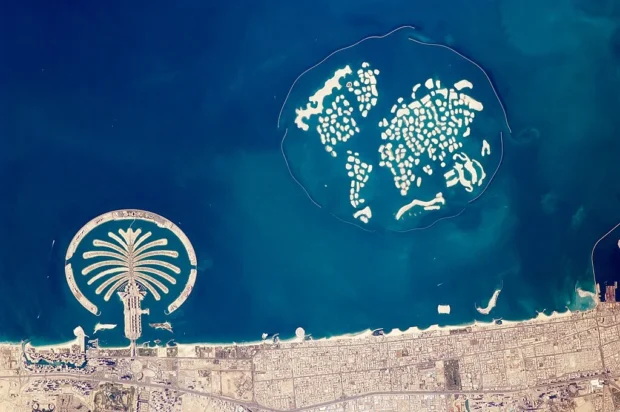In the radiant heart of Dubai, United Arab Emirates, lies a spectacle of human ambition and natural harmony – Palm Jumeirah. This iconic island is not merely an architectural marvel but a convergence of history, culture, and enduring creativity. For those drawn to the vastness of desert landscapes and the whispers of ancient trade routes, Palm Jumeirah offers a unique chapter in the narrative of modern heritage. Its proximity to Dubai’s vibrant city center and the expansive Arabian Gulf makes it a place of quiet reflection and exploration. Here, the silence of vast waters meets the pulse of innovative design, inviting visitors to witness a living testament to human endurance and the spirit of place.
Table of Contents
Arrival and Directions: Journey to the Heart of Palm Jumeirah
Reaching Palm Jumeirah is an experience that begins with the transition from the bustling cityscape of Dubai to the serene embrace of the sea. From Dubai International Airport, travelers may choose a taxi or ride-hailing service for a direct route lasting approximately 30 to 40 minutes, depending on traffic. The journey moves along Sheikh Zayed Road, a major artery pulsing with the city’s energy, before turning towards Al Sufouh Road that leads to the crescent-shaped island.
Public transport options include the Dubai Metro’s Red Line, alighting at the Nakheel Metro Station, followed by a short taxi ride across the Palm’s trunk. Those arriving from Dubai Creek or further afield may embark on a leisurely drive or an organized tour, allowing moments to savor the transition from urban life to the tranquil shores of the Palm.
Nearby accommodations abound along the mainland and within the island’s crescent, offering a range of experiences enveloped by the sea’s gentle whispers. Local eateries scattered along the trunk of the Palm provide insights into Emirati flavors and the rich culinary landscape influenced by the Gulf’s maritime heritage.
The Origin and Legacy of Palm Jumeirah
Palm Jumeirah rises like a palm leaf carved in the waters of the Arabian Gulf, an audacious blend of function and symbolism. The island was conceived in the early 2000s as part of Dubai’s vision to expand its coastline and create new realms for habitation and leisure. Constructed using millions of cubic meters of sand and rock, its engineering marvel reflects the perseverance of human creativity against the vast, arid backdrop.
This man-made island is more than a feat of urban planning; it embodies a dialogue between ancient maritime culture and contemporary ambition. The palm shape harks back to the date palm’s significance in Arabian life – a symbol of sustenance, shade, and endurance in desert environments. Thus, Palm Jumeirah stands as a modern echo of traditions, linking the past’s quiet resilience with the present’s inventive spirit.
For a wider view of Dubai’s rich culture and architecture beyond Palm Jumeirah, see our guide to Unmissable Sights and Stories Waiting in Dubai.
Crafting the Island: A Monument of Patience
The creation of Palm Jumeirah was a monumental task involving precise geological considerations and innovative construction techniques. The island’s foundation rests upon sand dredged from the sea floor, carefully placed to resist the ocean’s tides and preserve marine ecosystems. This balance of nature and human intervention is a quiet narrative of respect for the surrounding environment, a subtle act of conservation amid urban expansion.
Exploring Palm Jumeirah: What Awaits Beyond the Shore
Walking along the trunk of Palm Jumeirah reveals a tapestry of experiences, from quiet beaches kissed by the Gulf’s gentle waves to bustling promenades lined with cafes and artisan shops. For those interested in heritage and cultural landscapes, small galleries and local craft shops offer glimpses into Emirati artistry and traditional crafts, subtly woven into this modern setting.
The island’s crescent, a protective breakwater, shelters luxury resorts and private residences, yet even here, the vastness of the sea invites contemplation. Visitors often find a gentle hush descending at dawn or dusk, moments when the horizon seems infinite and the sands and water merge into a timeless expanse.
Visitor Tips: Timing and Tours
The best time to visit Palm Jumeirah is during the cooler months, from November to March, when the desert breeze softens the heat and the days extend gently into pleasant evenings.
After exploring Palm Jumeirah’s unique blend of innovation and heritage, you might enjoy a visit to the peaceful Tian Tan Buddha in Hong Kong, a different kind of serene landmark showcasing cultural harmony and spiritual reflection. Tian Tan Buddha in Hong Kong
Weekdays offer a quieter ambiance compared to weekends when locals and tourists alike gather to enjoy the island’s offerings.
Guided tours are available and recommended for those wishing to delve deeper into the island’s engineering and environmental aspects. Booking in advance ensures a place and provides access to areas otherwise restricted to casual visitors.
Reservations might be needed for dining establishments or specific attractions; checking online ahead of time is advisable.
Respecting the Island’s Spirit: Conservation and Culture
Palm Jumeirah is not only a symbol of modernity but a reminder of the importance of heritage conservation in an ever-changing landscape. Visitors are encouraged to appreciate the island’s natural flora and fauna, including the marine life thriving beneath the waters. Efforts to protect these delicate ecosystems reflect a broader commitment to maintaining cultural and environmental harmony.
The surrounding waters, often home to diverse fish species and coral formations, invite respectful observation and sometimes guided snorkeling excursions, linking the island’s contemporary stride with the enduring natural world.
Useful Resources and Further Reading
For those seeking detailed information or wishing to plan their visit in greater depth, the official Nakheel website offers comprehensive insights into Palm Jumeirah’s development, current events, and amenities. Access it through Nakheel Official Site.
Additionally, exploring Dubai’s cultural heritage through museums and heritage sites around the city enriches the visit to Palm Jumeirah, providing a fuller understanding of the intricate tapestry that weaves together this land and sea.
Final Reflections: The Quiet Majesty of Palm Jumeirah
As the sun dips beneath the horizon, casting golden hues over Palm Jumeirah, one is often struck by the island’s silent testimony to human endurance and vision. The convergence of natural elements and human craft creates a space not just for leisure but for reflection on progress and preservation. Palm Jumeirah invites all who walk its shores to pause and listen – to the ancient winds, the enduring sea, and the whispers of a heritage reimagined for the modern world.

